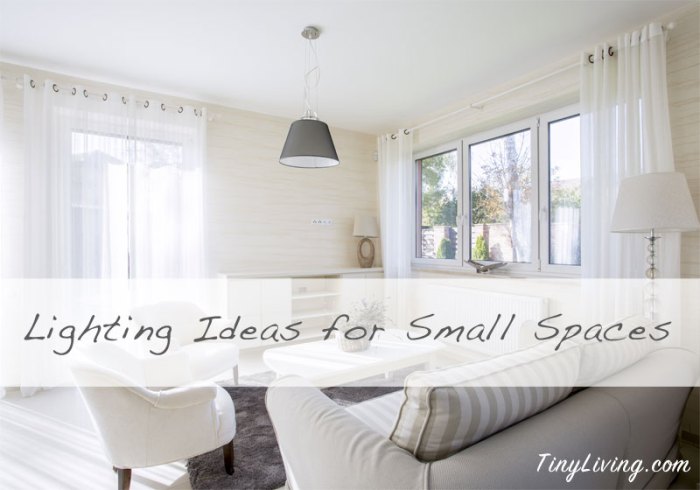Kicking off with Lighting design for small spaces, this opening paragraph is designed to captivate and engage the readers, setting the tone semrush author style that unfolds with each word.
Understanding how lighting can transform small spaces is crucial for creating a cozy and functional environment. In this guide, we’ll explore the key aspects of lighting design for compact areas, from maximizing light to strategic placement.
Understanding the Basics of Lighting Design for Small Spaces

In small spaces, proper lighting design is crucial to create a functional and aesthetically pleasing environment. The right lighting can make a room feel larger, enhance its ambiance, and improve functionality. Understanding the basics of lighting design for small spaces is essential to maximize the potential of these areas.
Importance of Lighting in Small Spaces
In small spaces, lighting plays a significant role in shaping the perception of size and functionality. Well-planned lighting can create the illusion of a larger space by brightening dark corners and highlighting key features. It also contributes to the overall atmosphere and mood of the room, making it more inviting and comfortable.
Key Factors to Consider in Lighting Design
- Lighting Levels: Consider the type of activities that will take place in the space and adjust the lighting levels accordingly. Task lighting for work areas, ambient lighting for overall illumination, and accent lighting to highlight specific elements.
- Lighting Placement: Strategically place light fixtures to ensure even distribution of light throughout the room. Avoid harsh shadows and dark spots by layering different types of lighting sources.
- Lighting Fixtures: Choose fixtures that are proportionate to the size of the space. Opt for compact and versatile fixtures that can provide sufficient light without overpowering the room.
Tips for Maximizing Light in Compact Spaces
- Use Light Colors: Paint walls and ceilings in light colors to reflect light and create a brighter space. Light-colored furniture and decor can also contribute to the overall brightness of the room.
- Maximize Natural Light: Make the most of natural light by keeping windows unobstructed and using sheer curtains to allow daylight to filter in. Consider adding mirrors to reflect natural light and visually expand the space.
- Layer Lighting: Combine different types of lighting, such as overhead fixtures, task lighting, and decorative lamps, to create a well-lit and visually dynamic environment. Dimmer switches can also help adjust the lighting intensity based on the time of day or activity.
Types of Lighting for Small Spaces
When designing lighting for small spaces, it is essential to consider the different types of lighting available to create a well-balanced and functional environment. Ambient, task, and accent lighting each serve specific purposes and can be utilized effectively in small rooms to enhance the overall design and functionality.
Ambient Lighting
Ambient lighting provides overall illumination to a space, creating a comfortable and inviting atmosphere. In small rooms, ambient lighting can be achieved through the use of ceiling lights, wall sconces, or track lighting. Soft, diffused light helps to make the space feel larger and more open.
Task Lighting
Task lighting is focused light that illuminates specific areas where activities such as reading, cooking, or working take place. In small spaces, task lighting is crucial for providing adequate light for tasks without overwhelming the room. Examples of task lighting fixtures suitable for small spaces include desk lamps, under cabinet lights, and adjustable wall-mounted fixtures.
Accent Lighting
Accent lighting is used to highlight architectural features, artwork, or other focal points in a room. In small spaces, accent lighting can create visual interest and depth, drawing attention to key elements. Examples of accent lighting fixtures suitable for small spaces include wall washers, picture lights, and track lighting with adjustable heads.
Overall, by incorporating a combination of ambient, task, and accent lighting, small spaces can be effectively illuminated to create a functional, visually appealing environment.
Lighting Layout and Placement
:max_bytes(150000):strip_icc()/ScreenShot2022-03-26at12.37.36PM-586dacf253284ba28f59fcc51b7e6bcb.png?w=700)
When it comes to lighting design for small spaces, strategic placement plays a crucial role in enhancing the functionality and aesthetics of the area. Proper lighting layout can make a compact room feel more spacious, inviting, and well-balanced.
Designing a Lighting Plan for a Small Room
Creating a lighting plan for a small room involves considering the different functions of the space and how lighting can support each of them effectively. Here are key points to keep in mind:
- Task Lighting: Install task lighting, such as under cabinet lights in the kitchen or a desk lamp in the study area, to provide focused illumination for specific activities.
- Ambient Lighting: Use ambient lighting, like recessed lights or wall sconces, to create overall illumination and ensure that the room is well-lit without harsh shadows.
- Accent Lighting: Incorporate accent lighting, such as track lights or picture lights, to highlight architectural features, artwork, or other focal points in the room.
- Dimmers: Install dimmer switches to adjust the brightness of the lights according to the time of day, mood, or specific tasks, providing flexibility and control over the lighting levels.
- Natural Light: Maximize natural light by keeping windows unobstructed and using sheer curtains to allow sunlight to filter into the room, complementing artificial lighting sources.
Creating Visual Interest through Lighting Placement
Strategic placement of lighting fixtures can also help create visual interest and enhance the overall design of a small space. Here are some tips to achieve this:
- Layered Lighting: Combine different types of lighting, such as overhead fixtures, wall sconces, and table lamps, to create depth and dimension in the room, adding visual interest.
- Highlight Features: Use lighting to draw attention to architectural details, decor elements, or focal points in the room, adding drama and emphasis to specific areas.
- Play with Textures: Experiment with lighting placement to highlight textures, materials, and surfaces, creating contrast and visual intrigue in the space.
- Wall Washing: Position lights to wash walls with soft, indirect light, creating a warm and inviting ambiance while visually expanding the perceived size of the room.
- Statement Fixtures: Incorporate statement light fixtures, such as chandeliers or pendant lights, as focal points that add personality and style to the space, elevating the overall design.
Lighting Solutions for Specific Small Spaces

When it comes to lighting design for small spaces, it’s essential to find the right balance between functionality and aesthetics. In this section, we will explore lighting design ideas for small bedrooms, suggest lighting solutions for small kitchens or bathrooms, and discuss creative ways to illuminate small living rooms or home offices.
Lighting Design Ideas for Small Bedrooms
In small bedrooms, it’s crucial to maximize space while ensuring proper lighting for various activities such as reading, relaxing, or getting ready. Consider using a combination of ambient lighting, task lighting, and accent lighting to create a cozy and functional atmosphere. Wall sconces, pendant lights, and bedside lamps are great options to provide adequate illumination without taking up valuable floor space.
Lighting Solutions for Small Kitchens or Bathrooms
Small kitchens and bathrooms can benefit from bright, focused lighting to enhance visibility and functionality. Under cabinet lighting, recessed lights, and track lighting are excellent choices to illuminate work surfaces and highlight key areas. Additionally, consider installing dimmer switches to adjust the light intensity based on the time of day or specific tasks.
Creative Ways to Illuminate Small Living Rooms or Home Offices, Lighting design for small spaces
In small living rooms or home offices, it’s essential to create a well-lit environment that promotes productivity and relaxation. Opt for adjustable floor lamps, wall-mounted lights, or overhead fixtures to save space and provide adequate lighting for different activities. Incorporating natural light through windows or skylights can also help open up the space and make it feel more spacious.
In conclusion, mastering the art of lighting design for small spaces can truly elevate the ambiance and functionality of your home. By carefully considering the types of lighting, layout, and fixtures, you can create a space that is both visually appealing and practical.
Looking to add some depth to your walls? Check out these innovative textured wall treatments for added dimension that can transform any room into a work of art.
Bring the calming vibes of the coast into your home with our coastal home décor inspiration. From nautical accents to sandy hues, create your own seaside retreat.
Struggling to find the perfect paint color for your small space? Our guide to the best paint colors for small rooms will help you make the most of every inch, creating a cozy and inviting atmosphere.




